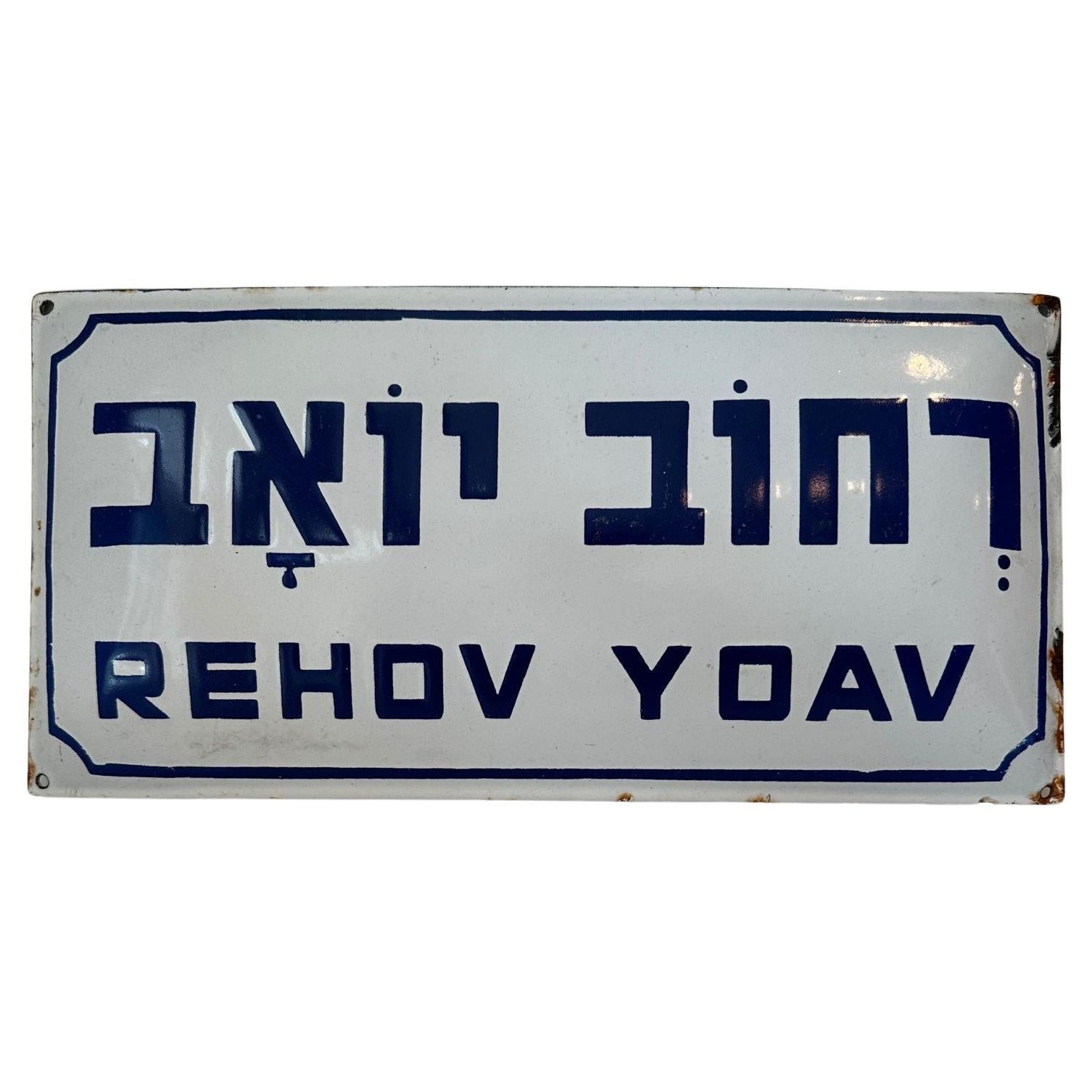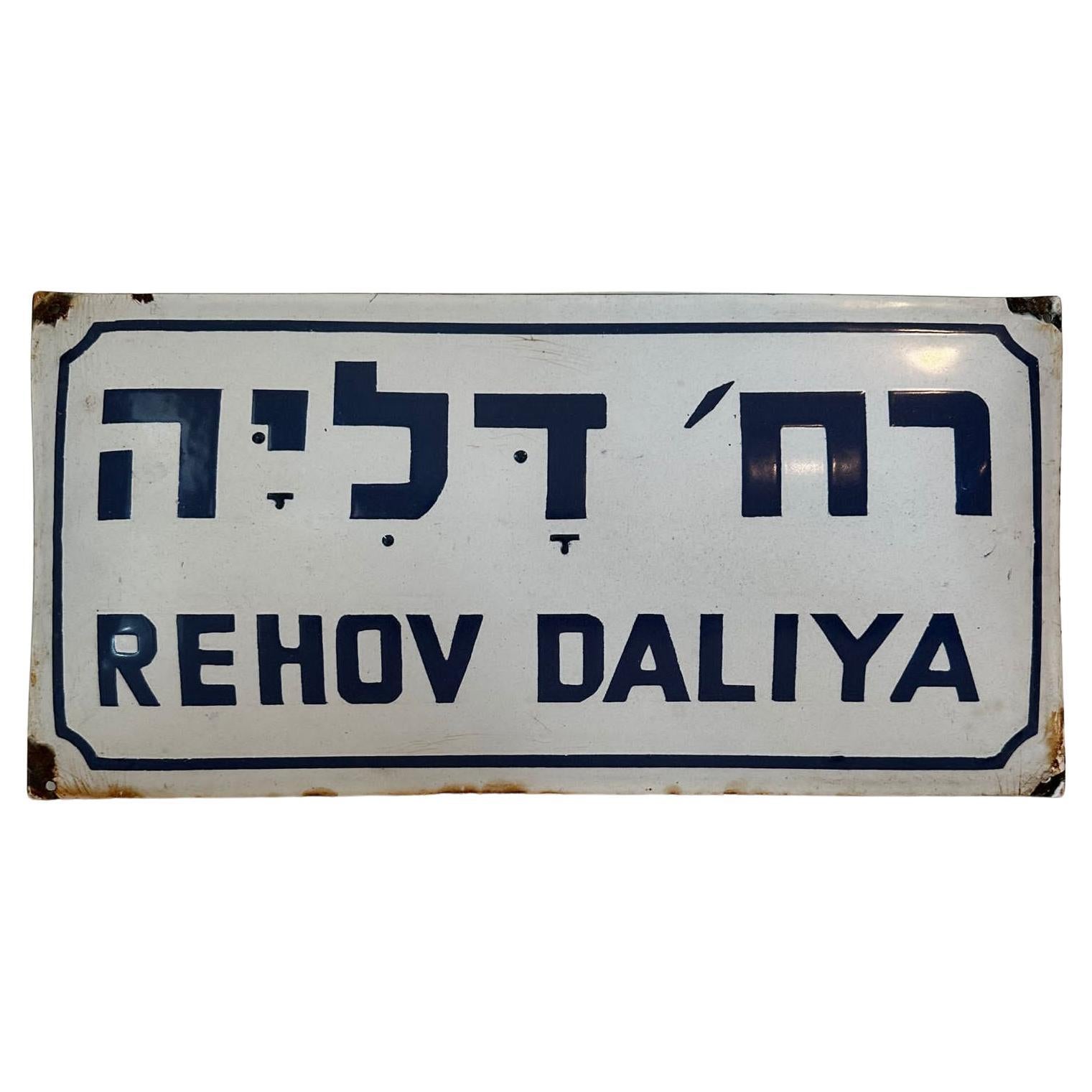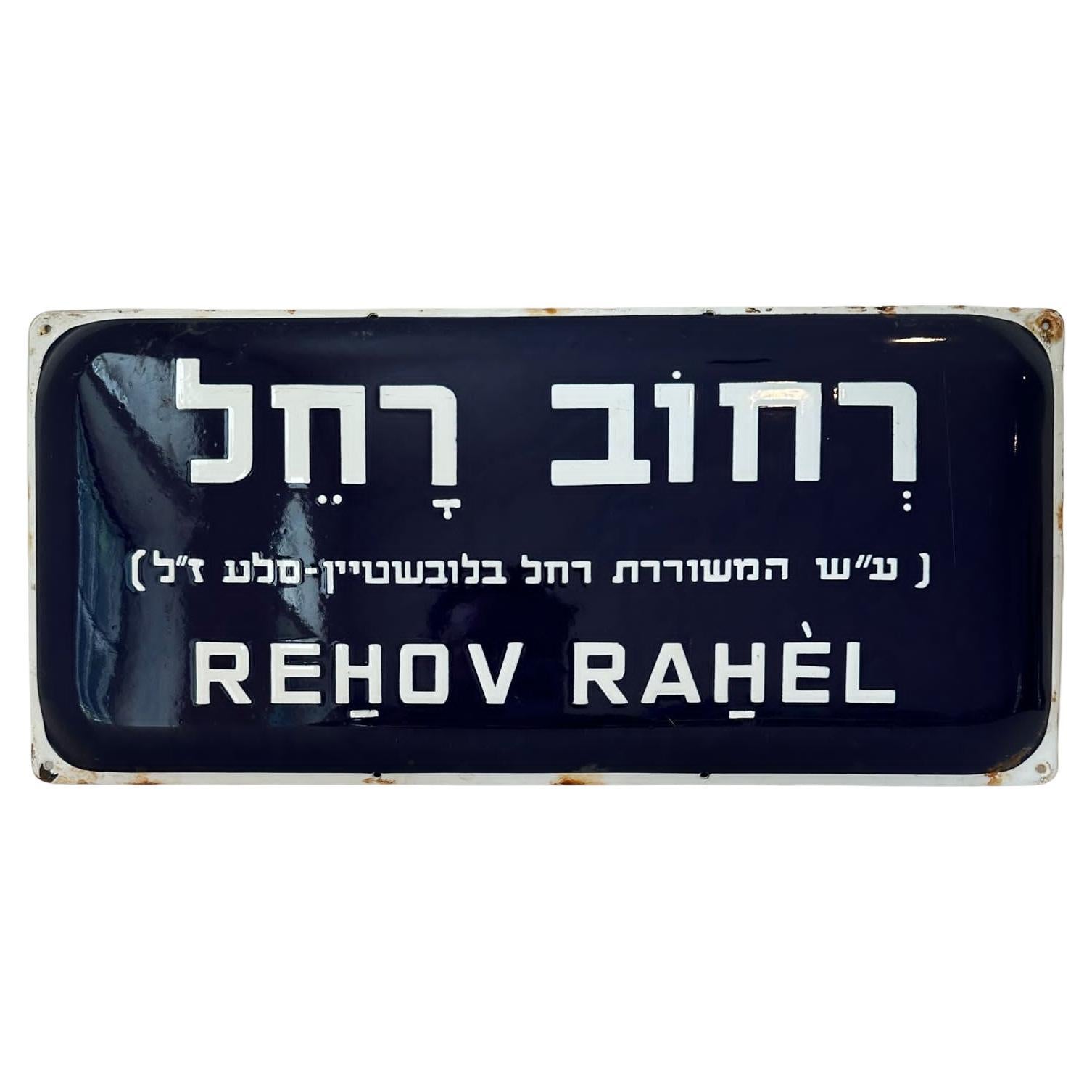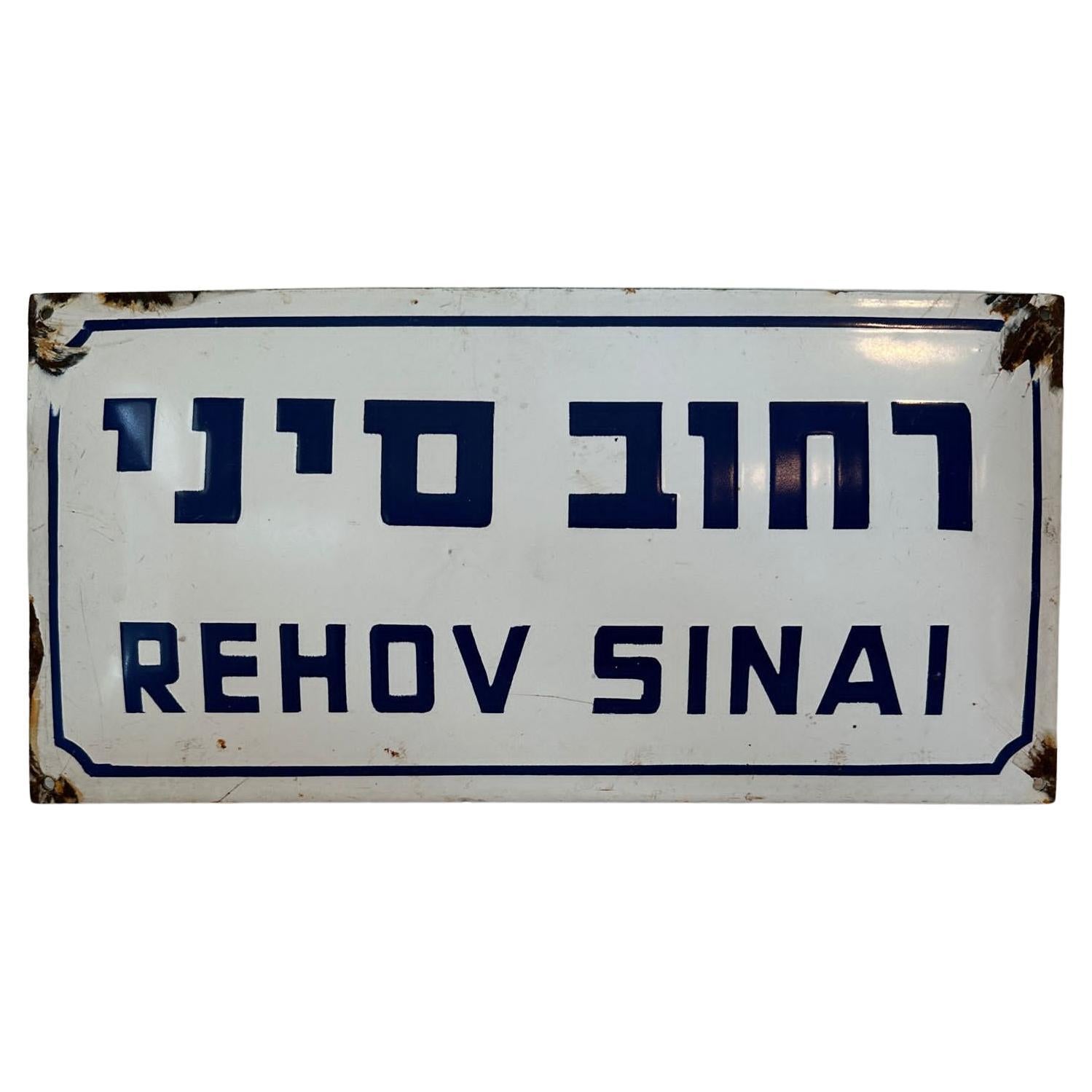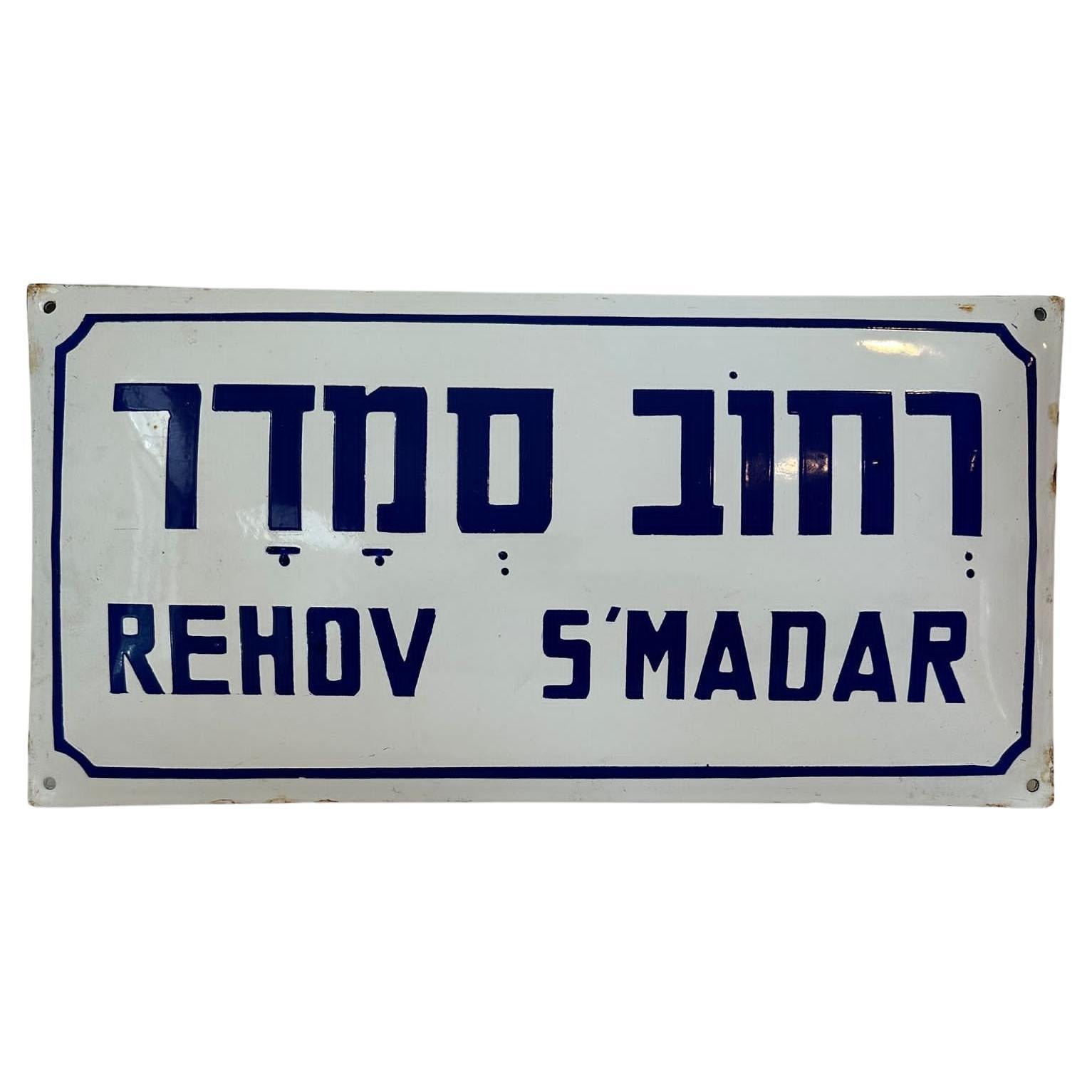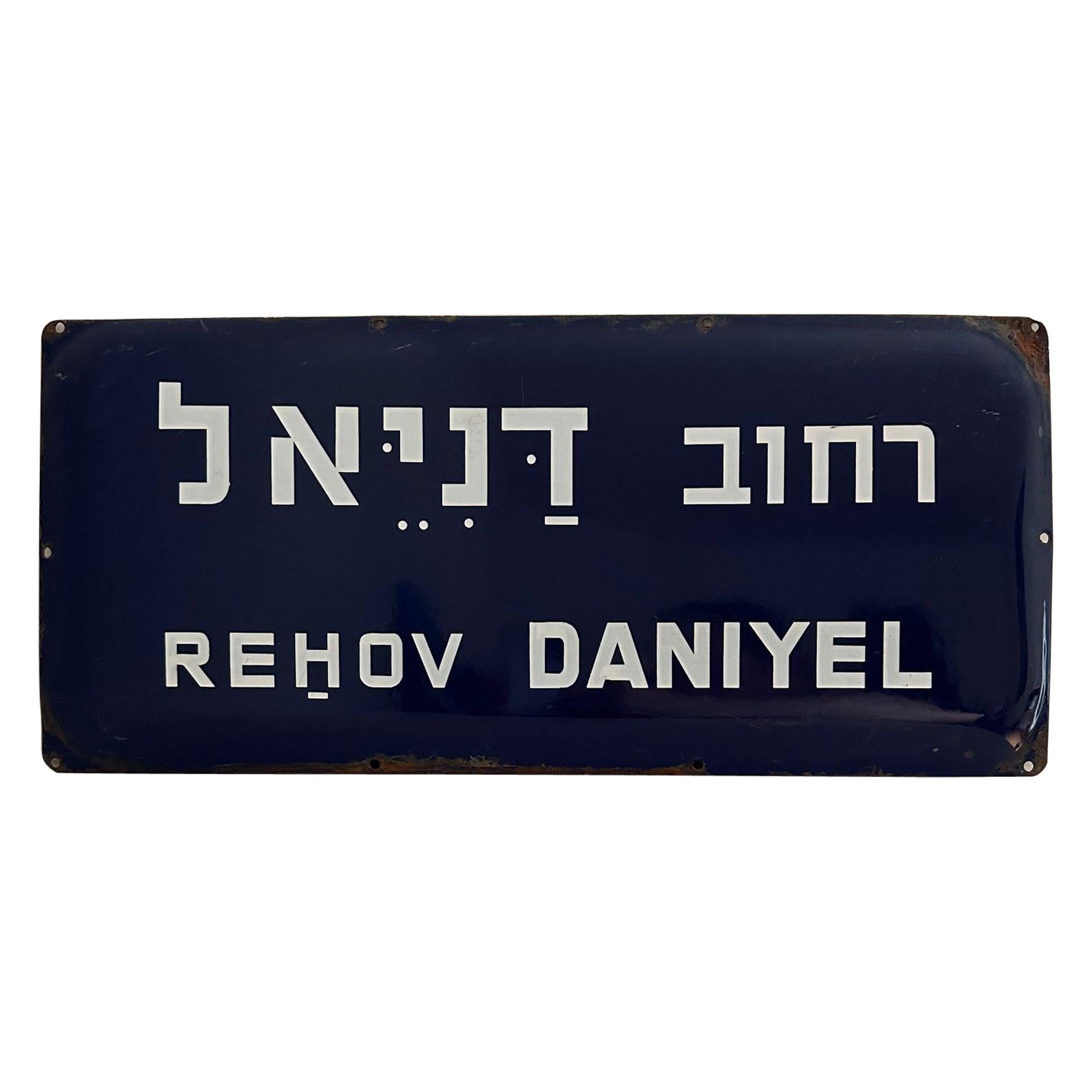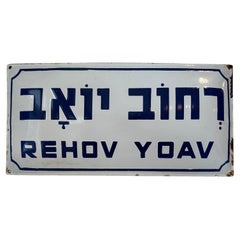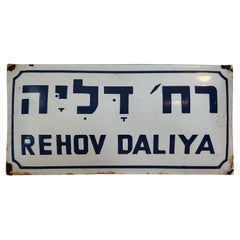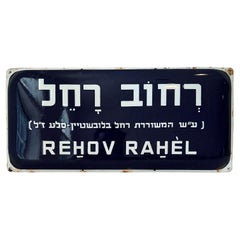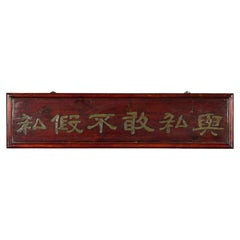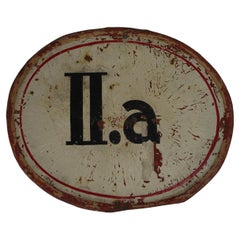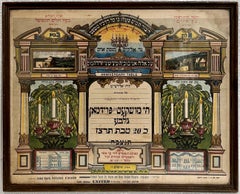Items Similar to Mid-20th Century Enamel and Iron Israeli 'Moriya' Street Name Sign
Want more images or videos?
Request additional images or videos from the seller
1 of 7
Mid-20th Century Enamel and Iron Israeli 'Moriya' Street Name Sign
$1,440
$1,80020% Off
£1,107.74
£1,384.6820% Off
€1,285.78
€1,607.2220% Off
CA$2,030.74
CA$2,538.4320% Off
A$2,274.77
A$2,843.4720% Off
CHF 1,194.79
CHF 1,493.4920% Off
MX$27,660.53
MX$34,575.6620% Off
NOK 15,129.99
NOK 18,912.4920% Off
SEK 14,362.43
SEK 17,953.0420% Off
DKK 9,596.24
DKK 11,995.3020% Off
About the Item
Mid-20th century handmade Israeli street name sign. Made of enamel and iron, this street sign was created shortly after the establishment of the state of Israel in 1948. The sign is written in bolt white letters over a dark blue background, alluding to the colors of the national flag of the newly established state.
The sign names the street 'Moriya' in Israel, in both Hebrew and English letters (in transliteration).
The origin of the name 'Moriya' (also spelled Moriah) comes from the Bible, where it is mentioned in the context of Mount Moriah on which the sacrifice of Isaac took place and on which the Temple was built. Mount Moriah is also known as the Temple Mount. Moriah is also a type of plant similar in its shape to the lamp that was lit in the Temple.
Every item in Menorah Galleries is accompanied by a lifetime “Certificate of Authenticity” and additional documentation and information regarding the individual artifact and its culture.
- Dimensions:Height: 8.5 in (21.59 cm)Width: 19 in (48.26 cm)Depth: 1 in (2.54 cm)
- Style:Mid-Century Modern (Of the Period)
- Materials and Techniques:
- Place of Origin:
- Period:
- Date of Manufacture:Circa 1950
- Condition:Wear consistent with age and use.
- Seller Location:New York, NY
- Reference Number:1stDibs: LU5281235327272
About the Seller
5.0
Recognized Seller
These prestigious sellers are industry leaders and represent the highest echelon for item quality and design.
Established in 2006
1stDibs seller since 2020
130 sales on 1stDibs
Typical response time: 1 to 2 days
- ShippingRetrieving quote...Shipping from: New York, NY
- Return Policy
Authenticity Guarantee
In the unlikely event there’s an issue with an item’s authenticity, contact us within 1 year for a full refund. DetailsMoney-Back Guarantee
If your item is not as described, is damaged in transit, or does not arrive, contact us within 7 days for a full refund. Details24-Hour Cancellation
You have a 24-hour grace period in which to reconsider your purchase, with no questions asked.Vetted Professional Sellers
Our world-class sellers must adhere to strict standards for service and quality, maintaining the integrity of our listings.Price-Match Guarantee
If you find that a seller listed the same item for a lower price elsewhere, we’ll match it.Trusted Global Delivery
Our best-in-class carrier network provides specialized shipping options worldwide, including custom delivery.More From This Seller
View AllMid-20th Century Enamel and Iron Israeli 'Yoav' Street Name Sign
Located in New York, NY
Mid-20th century handmade Israeli street name sign. Made of enamel and iron, this street sign was created shortly after the establishment of the state o...
Category
Vintage 1940s Israeli Mid-Century Modern Decorative Art
Materials
Enamel, Iron
$1,440 Sale Price
20% Off
Mid-20th Century Enamel and Iron Israeli 'Daliya' Street Name Sign
Located in New York, NY
Mid-20th century handmade Israeli street name sign. Made of enamel and iron, this street sign was created shortly after the establishment of the state o...
Category
Vintage 1940s Israeli Mid-Century Modern Decorative Art
Materials
Enamel, Iron
$1,440 Sale Price
20% Off
Mid-20th Century Enamel and Iron Israeli 'Rah'el' Street Name Sign
Located in New York, NY
Mid-20th century handmade Israeli street name sign. Made of enamel and iron, this street sign was created shortly after the establishment of the state of Israel in 1948. The sign is written in bolt white letters over a dark blue background, alluding to the colors of the national flag of the newly established state.
The sign names the street 'Ra'hel' (Rachel) in Jerusalem in both Hebrew and English letters (in transliteration).
The origin of the name Rachel comes from the book of Genesis in the Bible, where it appears as the name of a biblical figure - a shepherdess, the wife of Jacob our father, the daughter of Laban the Armenian, the sister of Leah his mother and one of the four mothers of the people of Israel. Rachel was also the mother of Joseph the righteous and Benjamin.
However, this sign refers to the poet Rahel Bluwstein, more famously known as Rachel the Poetess, who is considered the “founding mother...
Category
Vintage 1950s Israeli Mid-Century Modern Decorative Art
Materials
Enamel, Iron
$1,440 Sale Price
20% Off
Mid-20th Century Enamel and Iron Israeli 'Sinai' Street Name Sign
Located in New York, NY
Mid-20th century handmade Israeli street name sign. Made of enamel and iron, this street sign was created shortly after the establishment of the state of Israel in 1948. The sign is ...
Category
Vintage 1940s Israeli Mid-Century Modern Decorative Art
Materials
Enamel, Iron
$1,440 Sale Price
20% Off
Mid-20th Century Enamel and Iron Israeli 'S'madar' Street Name Sign
Located in New York, NY
Mid-20th century handmade Israeli street name sign. Made of enamel and iron, this street sign was created shortly after the establishment of the state o...
Category
Vintage 1940s Israeli Mid-Century Modern Decorative Art
Materials
Enamel, Iron
$1,440 Sale Price
20% Off
Mid-20th Century Enameled and Iron Israeli 'Daniyel' Street Name Sign
Located in New York, NY
Mid-20th century handmade Israeli street name sign. Made of enamel and iron, this street sign was created shortly after the establishment of the state of Israel in 1948. The sign is ...
Category
Vintage 1950s Israeli Mid-Century Modern Decorative Art
Materials
Enamel, Iron
$1,440 Sale Price
20% Off
You May Also Like
Huge 19th Century Gilded and Reverse Painted Shop Sign
Located in London, GB
A fabulous huge late 19th Century Spanish gilded and painted glass sign from a bar in Barcelona.
A rare survivor still in its original wooden frame with multiple layers of paint. Th...
Category
Antique Late 19th Century Spanish Art Nouveau Architectural Elements
Materials
Glass, Wood, Paint
Vintage Shop Sign with Gilt Calligraphy on Lacquered Ground
Located in Yonkers, NY
A vintage Chinese horizontal shop sign from the mid 20th century with lacquered finish, carved and gilt calligraphy. Created in China during the midcentury period, this horizontal shop sign features an outer molded frame surrounding a beautiful calligraphic text. Six words, carefully carved and gilded, stand out on a dark reddish brown lacquered ground. The sign has been fitted with two ring pulls on its upper edge to allow it to be hung on a wall. With its clean lines and gilded calligraphy, this vintage Chinese shop sign...
Category
Mid-20th Century Chinese Architectural Elements
Materials
Wood
Sign from the School Classroom Door, 1900s
Located in Praha, CZ
Hand painted sign from classroom door.
Made around 1900s.
Category
Antique Early 1900s European Art Nouveau Paintings
Materials
Metal
$570 / item
Rare Palestine Antique Hebrew Judaica Yahrzeit Synagogue Sign Memorial Plaque
Located in Surfside, FL
Circa 1890-1920. This Neoclassical, Judaic, Egyptian revival, Orientalist Mizrach sign, was produced in British Mandate Palestine by the chromolithograph process at the beginning of the 20th century. It pictures vignettes of holy places. with a hand written memorial. It was for the Tzedakah charity fund for the century-old institutions in Jerusalem: The great "Torah Center Etz Chaim"; a Free Kitchen for poor children and orphans; the famous Bikur Cholim Hospital with its dispensaries and clinics and the only Home for Incurable Invalids in Eretz Israel. They also worked with Arthur Szyk and Alfred Salzmann.. The A.L. Monsohn Lithographic Press (Monzon Press, Monson Press, דפוס אבן א"ל מאנזאהן, דפוס מונזון) was established in Jerusalem in 1892 by Abraham-Leib (or Avrom-Leyb) Monsohn II (Jerusalem, c.1871-1930) and his brother Moshe-Mordechai (Meyshe-Mordkhe). Sponsored by members of the Hamburger family, the brothers had been sent to Frankfurt, Germany in 1890 to study lithography. Upon returning to Jerusalem in 1892 with a hand press, they established the A.L. Monsohn Lithographic Press in the Old City of Jerusalem. According to the Information Center for Israeli Art A.L. Monsohn "created complex decorations for documents and oriental calendars that combined the tradition of Jewish art with modern printing techniques such as photographic lithography, raised printing and gilding."
The founders of the Monsohn press produced Jewish-themed color postcards, greeting cards, Jewish National Fund stamps, and maps documenting the evolution of the Jewish settlement in Eretz Israel in the nineteenth-twentieth centuries; religious material such as decorative plaques for synagogues, portraits of Old Yishuv rabbis such as Shmuel Salant, Mizrah posters indicating the direction of prayer for synagogues, memorial posters, and posters for Sukkot booths; color frontispieces for books such as Pentateuch volumes and the early song collections of Abraham Zvi Idelsohn (e.g., Shire Zion, Jerusalem 1908); artistic wedding invitations; and labels, packaging and advertisements for the pioneering entrepreneurs of Eretz Israel. The texts appearing in the Monsohn products were in several languages: Hebrew, Arabic, Yiddish, English, German (e.g., a c1920 trilingual Hebrew-English-Arabic "Malaria Danger" broadside warning the public of mosquitoes spreading malaria). Many of the brilliantly colored postcards and maps can be seen online as can the artistic invitations to his children's weddings which Monsohn published in the Jerusalem Hebrew press.
For years, the Monsohn (later, Monson/Monzon) Press was considered the best and most innovative in the country—pioneering in such techniques as gold-embossing and offset printing, among others. Early items for tourists included collections of Flowers of the Holy Land (c. 1910–1918)—pressed local flowers accompanied by scenes from the Eretz Israel countryside and relevant verses from the Bible, edited by Jsac Chagise (or Itzhak Haggis), an immigrant from Vitebsk, and bound in carved olive wood boards. Shortly after World War I Monsohn (now spelled מונזון) used zincography to produce the prints included in the Hebrew Gannenu educational booklets for young children illustrated by Ze'ev Raban of the Bezalel Academy of Art and Design and printed in Jerusalem by Hayim Refael Hakohen (vol. 1, 1919; vols. 2–3, 1920). In 1934 Monsohn moved into the new, western part of Jerusalem, in a shop with four presses and 30 workers, including Abraham-Leib's sons, David, Yosef, Moshe and Shimon, and his daughter Raytse's husband, Abraham Barmacz. The concern did business with all sectors of the city's population, including Arabs, for whom they printed in Arabic. Among their clients were members of the Ginio, Havilio, and Elite families, and Shemen, Dubek, and other renowned national brands, manufacturing products such as wine, candies, oil, and cigarettes. They also printed movie and travel posters, and government posters, postcards and documents, hotel luggage labels...
Category
Early 20th Century Aesthetic Movement More Art
Materials
Lithograph
Antique Bronze Train Sign - 923, 1910s
Located in Esbjerg, DK
A very heavy and patinated bronze sign with raised numerals 923. The sign is handmade in 1-2 cm thick stock and weighs in around 8 kg. It comes from a P 923 train that was built by B...
Category
Vintage 1910s Danish Arts and Crafts Historical Memorabilia
Materials
Bronze
$782 Sale Price
32% Off
Antique Harvard Ave. Porcelain Sign c.1900-1910
Located in San Francisco, CA
ABOUT
An original double sided enameled porcelain Harvard Ave street sign.
Shown with life size hand model for scale.
CREATOR Unknown.
DATE OF MANUFACTURE c.1900-1900.
...
Category
Early 20th Century Industrial Signs
Materials
Enamel, Steel
More Ways To Browse
Enamel Letters
Israel Mid Century Modern Furniture
Israel Lamp
Vintage Enamel Letters
Adolfo Arenas Alonso
Adolfo Arenas
Akiko Sugiyama
Amador Lugo
Arthur Shilstone Artist
Bill Stilson
Boris Riab
Burnett Eiffel Tower
Burnett Painting Eiffel Tower
Capodimonte Wall Plaque
Carta Blanca
Della Robbia Wall Plaque
Este Made In Italy For Tiffany
Geoff Hargadon
